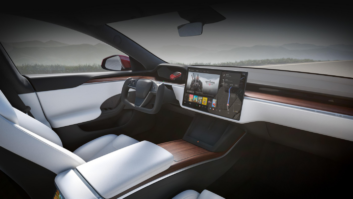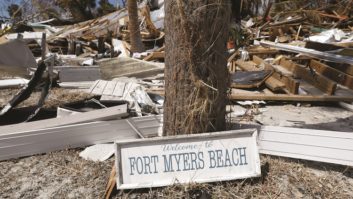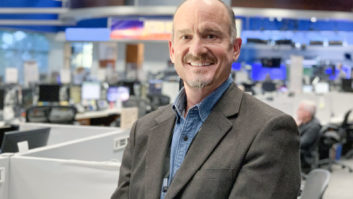The author is principal consultant at Alkira Technologies in Hong Kong and a frequent contributor to Radio World’s sister publication TV Technology.
HONG KONG — The recent events in Japan have really gripped the attention of the world, and my attention in particular.
There are so many of us in the worldwide broadcast community who have a sense of respect and gratitude towards the Japanese engineers who have brought us so many wonderful technologies and products that make television production, broadcasting and viewing a more efficient, cost-effective and satisfying activity.

An aerial view of damage to Wakuya, Japan, after a 9.0 Mw earthquake and subsequent tsunami devastated the area. U.S. Navy photo by Mass Communication Specialist 3rd Class Alexander Tidd
Sony, Matsushita, Hitachi, Ikegami, NEC, For-A, Toshiba, Sanyo, Sharp, Akai, Canon, Fujifilm, Nikon, NHK and so many other Japanese brands have become household names internationally and have embedded themselves into our daily lives by way of the products and programming that we have come to take for granted.
The Tōhoku earthquake and tsunami is therefore a disaster that somehow tugs more much more deeply than usual on our heartstrings. I’m “feeling” for the victims of this disaster in a much deeper way than I did for previous similar events, wherever they occurred in the world.
Logical brain
But as much as emotions may rule in the impact of an unfolding story, the logical side of an engineer’s brain is always active, and is always taking on each new situation as a problem to be solved. But there are two directions in which to focus one’s intelligence in the effort to bring sense to a situation.
The first and more immediate direction is the problem at hand: finding and taking care of injured, dead, and missing people … and defusing the potential time bomb of a crippled nuclear power plant.
Telecommunications play a key role in this phase of our response. One of the most important emergency supply items dropped into the Indian Ocean tsunami disaster zones in 2004 was the humble portable transistor radio.
When things get really tough, the simplest form of communication is often the best. A smoke signal from a castaway on a beach is a classic example.
Bad enough it is for a survivor to be in the midst of the tsunami’s devastation, but like salt rubbed into a wound is the ongoing mystery that consumes the survivor when all electricity and telephone and other copper-based communications have been cut.
AM radio broadcasting is probably the most necessary service to be protected. Next above AM radio is simple two-way communication. Survivors trapped under rubble during the recent Christchurch, New Zealand, earthquake were exchanging SMS text messages with their loved ones, until the phone battery went flat.
For the rest of the world not actively caught up in any disaster, the live television images and sound are what bring the reality home to us. The live images of the recent tsunami bulldozing its way across seaside towns and villages left none of us in any mystery as to the seriousness of the situation, and the degree of help that would be needed. And the lack of detailed moving images of the activities inside the nuclear plant is adding greatly to our stress.
Hindsight
The other direction in which to apply one’s engineering intelligence is to the past, in an effort to analyze what went wrong and how might we be better prepared for such an event next time.
“An ounce of prevention is worth more than a pound of cure” is an old but very valid maxim. A multitude of “if only …” statements will resonate throughout the deserted concrete hallways of the soon-to-be-defunct nuclear power plants in Fukushima.

An aerial view of damage to northern Honshū, Japan, after a 9.0 Mw earthquake and subsequent tsunami devastated the area. U.S. Navy photo by Naval Air Crewman 1st Class Jay Okonek
If only they hadn’t put the diesel generators and their fuel tanks on the beach side of the power plant. If only they hadn’t put the whole power plant so close to the ocean, on what appears to be reclaimed land right at sea level. If only they hadn’t extended the operational life of the plant beyond the original February, 2011, decommission plan. If only they’d upgraded the battery backup UPS beyond the paltry 4 to 6 hours capability that it had.
It is easy to have a lot of wisdom in hindsight. It’s easy for some to be critical of the plant operators for what might have been poor management and risky technical design decisions. But people in glass houses should not throw stones.
I know of many broadcast facilities that are proverbial “sitting ducks” in that they are very poorly located or poorly constructed in terms of exposure to risk.
Our unfortunate friends and industry colleagues whom we sadly lost in the recent collapse of the CTV building in Christchurch are the indisputable proof of an ill-fated decision at some considerable time in the past.
New Zealand is a known earthquake zone. Japan’s east coast is a known tsunami zone. New Orleans has been known throughout living history as flood-prone from the Mississippi River to the north and hurricane prone from the Gulf of Mexico to the south.
We shouldn’t be surprised when floods, tsunamis, hurricanes and earthquakes happen. We should be surprised at how poorly the buildings and key facilities have been planned and located and built in the affected area.
But whatever emotional response may grip us as the technical facts unfold, the bottom line is that we are sorry for the deep trouble that our friends are now in, and our most constructive thoughts and love and active help go out to them.












